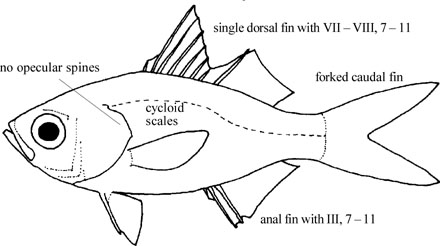CHANDIDAE
Perchlets (glassfishes)
By Koichi Shibukawa
 Ambassis urotaenia |
 Ambassis vachellii |
|
Small to moderate sized (up to 12 cm), oblong and compressed fishes. Lateral line continuous or interrupted at midway. Head compressed; eyes large; lower jaw subequal or projecting beyond upper jaw; spines or serrations on various parts of head (e.g., round of eye, snout, and margins of preopercle and interopercle); no opercular spine; villiform teeth on jaws and roof of buccal cavity; branchiostegals 6. Dorsal fin single, deeply notched before last spine, with VII or VIII spines and 7 - 11 soft rays; anal fin with III spines and 8 - 11 soft rays; pectoral fin with 11 - 17 soft rays; pelvic fin I, 5; caudal fin forked. Scales cycloid, moderately large and thin, and usually easy to be deciduous. Vertebrae 24 - 25. Color: subtranslucent or opaque, with silvery head and belly; fins hyaline, usually with black streaks and/or blotches on dorsal and caudal fins, tinged with yellow in some species.
Similar families occurring in the area. Apogonidae: two separate dorsal fins; II anal fin spines. Remarks. Found in freshwaters, brackish estuaries, mangroves, and shallow coastal waters around estuaries; usually forming aggregations, and feed on small crustaceans, insects, and fishes. Minor importance in fisheries, often marketed as dried and salted; some freshwater species treated as popular aquarium fish. |

|
|